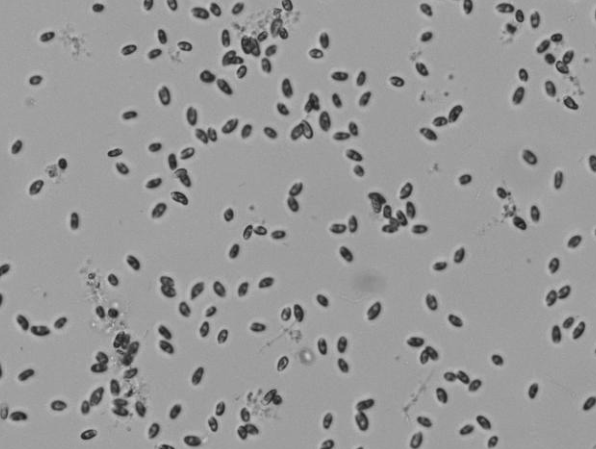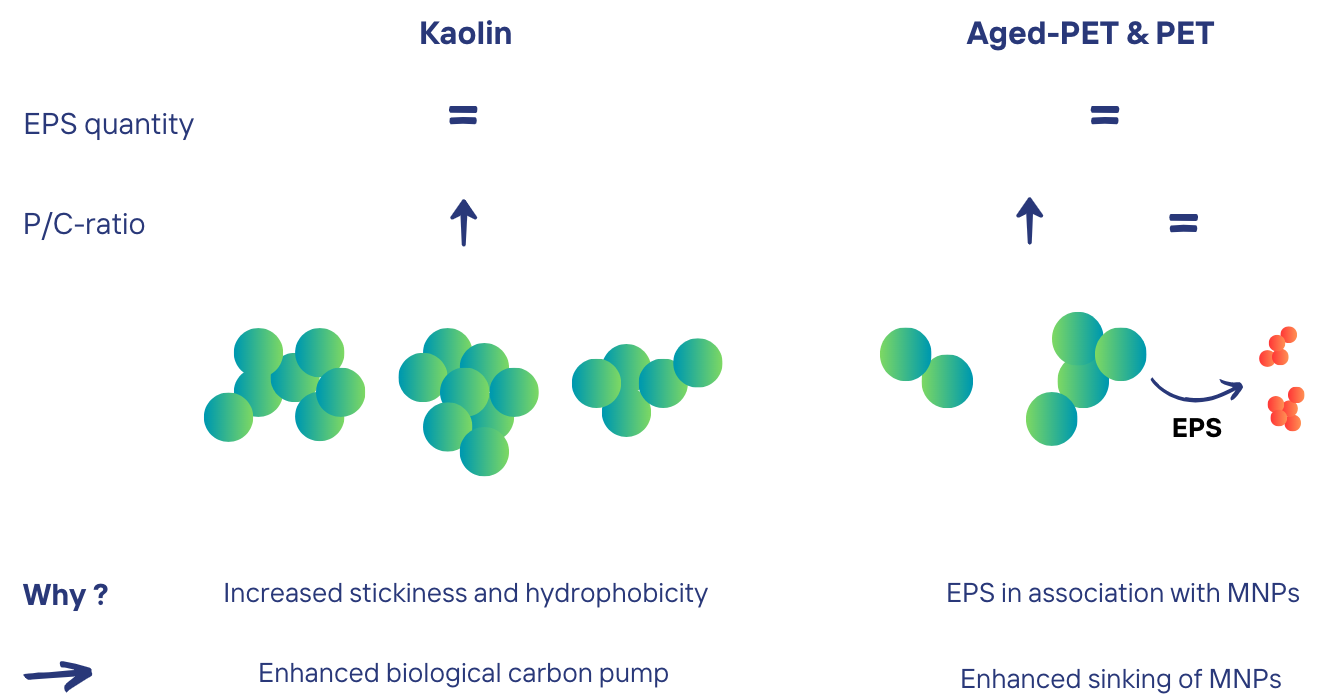Algal Responses to Micro- and Nanoplastic Exposure: Unraveling the Role of Extracellular Polymeric Substances
Introduction
Plastics have revolutionized modern life, providing solutions to countless human needs due to their versatility and affordability. However, this convenience comes at a significant environmental cost. With over 390 million tons of plastic produced annually, these materials are becoming increasingly ubiquitous in natural ecosystems, particularly in the oceans. While large plastic debris has long been recognized as a major pollutant, the breakdown of these materials into microplastics (MPs) and nanoplastics (NPs) is a more insidious and complex challenge. MPs, ranging from 1 µm to 5 mm, and NPs, smaller than 1 µm, are now pervasive in marine environments, posing a significant threat to aquatic organisms due to their small size and increased reactivity.
Micro- and nanoplastics (MNPs) differ fundamentally from larger plastic particles. Their minute size allows them to remain suspended in water, making them more mobile and more likely to be ingested by marine life. Furthermore, their high surface area enables them to adsorb toxic chemicals from the surrounding environment, increasing their potential toxicity. As these plastic particles continue to accumulate in the ocean, their impact on marine ecosystems, particularly on foundational organisms like microalgae, becomes a critical area of research.
Microalgae and the Role of Extracellular Polymeric Substances
Marine microalgae are microscopic, photosynthetic organisms that form the foundation of aquatic food webs. As primary producers, they convert sunlight into organic biomass through photosynthesis, providing the energy base for a wide range of marine organisms. The health and stability of marine ecosystems are therefore intimately tied to the well-being of these microalgae.
Microalgae are encased in a layer of extracellular polymeric substances (EPS), a complex mixture of biopolymers, including polysaccharides, proteins, and lipids. EPS play a crucial role in various cellular functions, such as protection against environmental stressors, adhesion, nutrient acquisition, and the formation of algal aggregates. These aggregates are essential for processes like the biological carbon pump, which transports carbon from the ocean surface to the deep sea, playing a significant role in global carbon cycling and climate regulation.
Recent studies suggest that EPS production may also serve as a protective mechanism against environmental contaminants, such as nanoparticles. This research aims to unravel the complex interactions between microalgae and MNPs, with a particular focus on the role of EPS in mediating these effects.

Research Overview: Addressing Critical Gaps in Microplastic Pollution Studies
This study addresses critical gaps in existing micro- and nanoplastic research by employing realistic exposure scenarios, including weathered plastics and natural particle controls. The research focuses on the saltwater microalga Rhodomonas salina and its response to various concentrations of polyethylene terephthalate (PET) particles, both pristine and aged, as well as kaolin, a natural clay mineral used as a control.
The microalgae were exposed to environmentally relevant concentrations of PET, aged-PET, and kaolin (10, 100, 1000, and 10,000 particles/mL) to assess their impact on algal growth, EPS production, and aggregation. The study's findings reveal nuanced insights into how microalgae respond to MNP exposure and highlight the importance of EPS in these interactions.

Key Findings: The Protective Mechanisms of Microalgae
The research uncovered several critical insights into how microalgae respond to MNP exposure:
- Impact on Algal Growth: Exposure to MNPs generally resulted in a decrease in the carrying capacity of algal cultures, indicating that MNPs have a negative impact on algal survival. However, an interesting trend was observed—despite this reduction in carrying capacity, the maximum growth rate of the algae increased across all exposure groups, including those exposed to kaolin. This paradoxical result suggests that while MNPs pose a stressor to microalgae, they may also trigger compensatory growth mechanisms.
- EPS Production and Composition: Contrary to the hypothesis that stressful conditions, such as MNP exposure, would lead to increased EPS production, the study did not detect a significant increase in EPS production after 10 days of exposure across any treatment group. However, the composition of the EPS did shift significantly, particularly in terms of the protein-to-carbohydrate (P/C) ratio. Kaolin exposure, in particular, led to a higher P/C ratio, indicating changes in the biochemical makeup of the EPS in response to different types of particles.
-
Aggregation Patterns: The study found clear distinctions between the effects of natural and synthetic particles on algal aggregation. Exposure to kaolin led to the formation of larger and more numerous algal aggregates, likely due to the flocculating properties of clay and the production of sticky, hydrophobic EPS. These aggregates were dominated by algal cells with a lower proportion of EPS, suggesting that larger aggregates have a lower surface-to-volume ratio and therefore less EPS bound to the surface.
In contrast, exposure to PET and aged-PET resulted in fewer and smaller algal aggregates. These aggregates had a higher proportion of algal cells relative to EPS, likely due to the strong affinity of EPS for the negatively charged MNPs. This binding preference reduces the availability of EPS to interact with algal cells, leading to the formation of smaller aggregates.

Environmental Implications: A Call for Further Research
The findings of this study have significant implications for understanding the environmental fate of MNPs and their potential impact on marine ecosystems. The formation of larger and denser plastic aggregates could lead to their removal from the water column through sedimentation. While this might seem beneficial, it raises concerns about the increased exposure of benthic (seafloor) organisms to MNPs, potentially disrupting the entire benthic food web.
The study's results suggest that EPS play a critical role in determining the fate of MNPs in marine environments, influencing both the size and composition of algal aggregates. Given the potential consequences for benthic communities, further research is urgently needed to explore the effects of MNPs on these organisms. Future studies should also continue to use environmentally relevant exposure scenarios, ideally incorporating multiple stressors to better mimic natural conditions.
Conclusion
This research represents a significant step forward in our understanding of how microalgae, a foundational component of marine ecosystems, respond to the growing threat of micro- and nanoplastics. By employing realistic exposure scenarios and focusing on the role of EPS, the study provides critical insights into the mechanisms that microalgae use to cope with MNP pollution. These findings not only enhance our ability to assess the risks posed by MNPs but also underscore the importance of protecting marine microalgae as a key element in maintaining the health and stability of ocean ecosystems.
As plastic pollution continues to escalate, the need for research that addresses these complex interactions becomes increasingly urgent. By shedding light on the subtle yet significant ways in which MNPs affect marine microalgae, this study contributes to a deeper understanding of the broader impacts of plastic pollution on marine life and the critical role of microalgae in mitigating these effects.
Bibliografie
Van jongs af aan was ik gefascineerd door de wetenschap, met een bijzondere interesse in de wereld om ons heen. Deze nieuwsgierigheid leidde me naar de studie wiskunde-wetenschappen in het middelbaar onderwijs. Al snel werd duidelijk dat de levenswetenschappen mij het meest aanspraken. De keuze voor een opleiding bio-ingenieurswetenschappen was dan ook een logische stap.
Tijdens mijn studies werd mijn passie voor water steeds duidelijker. Ik koos bewust voor keuzevakken die zich richtten op rivieren en oceanen. De complexiteit en het belang van deze ecosystemen fascineerden me enorm. De wetenschap dat we nog zo weinig weten over onze oceanen, was een constante drijfveer. Tijdens mijn Erasmusuitwisseling in Wenen verdiepte ik mijn kennis over waterlopen door vakken te volgen over de Donau en andere rivieren. Dit bevestigde mijn interesse in aquatische milieus.
Voor mijn thesis zocht ik bewust naar een onderwerp dat aansloot bij mijn passie voor de oceaan. Mijn onderzoek heeft mijn kennis over mariene microalgen en pollutie in de oceaan aanzienlijk vergroot en mijn motivatie om meer te leren over onze oceanen alleen maar versterkt.
Na het succesvol afronden van mijn studies ben ik klaar voor een nieuw avontuur. In oktober van dit jaar vertrek ik naar Zuid-Oost-Azië om mijn passie voor de zee verder te ontplooien. Deze reis zal niet alleen een onvergetelijke ervaring zijn, maar ook een unieke kans om mijn kennis over mariene ecosystemen in de praktijk te brengen. Ik kijk ernaar uit om te snorkelen, te duiken en de diverse onderwaterwerelden van deze regio te verkennen. Deze reis zal ongetwijfeld een grote inspiratiebron zijn voor mijn toekomstige carrière.
In een wereld die steeds meer geconfronteerd wordt met de gevolgen van klimaatverandering, is het behoud van onze oceanen belangrijker dan ooit. Door mijn academische kennis te combineren met mijn passie voor de zee, wil ik me inzetten voor een duurzame toekomst waarin mensen en natuur in harmonie samenleven.









